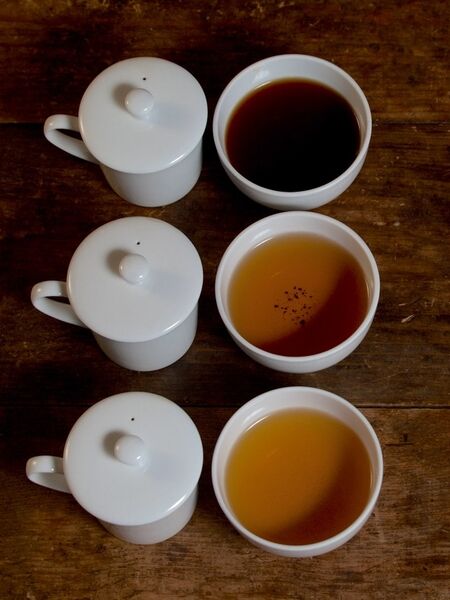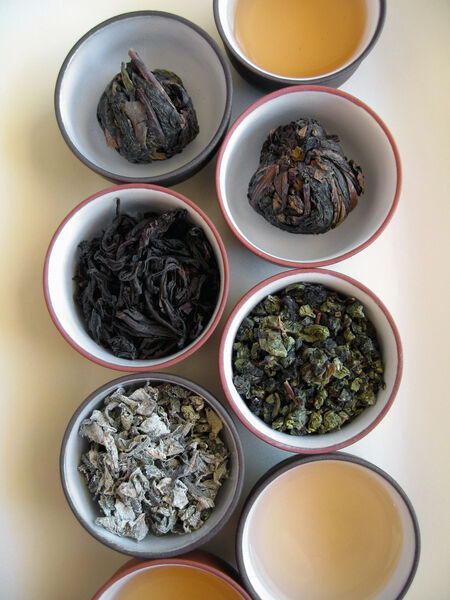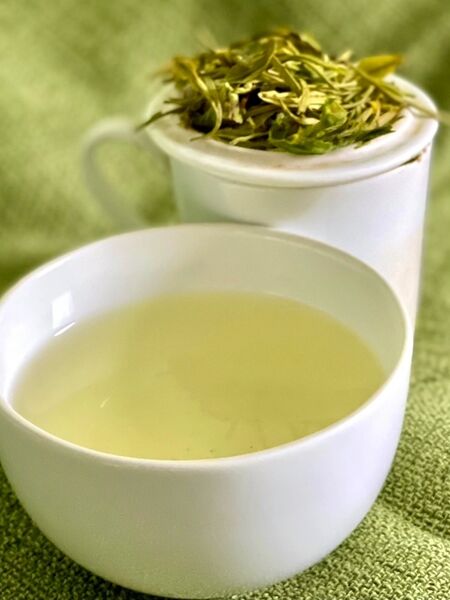Two Leaves and a Tastebud: How to Taste



In this lesson, we bring taste to the forefront. We'll explore the many different tastes of tea and the terminology created to explain them. By the end of this article, you'll be equipped with the knowledge to taste tea like a pro in your own home.
Before we begin tasting, you'll need the necessary tools. Obviously, you'll need teas, water (good quality, of course - no tap water!), a kettle, teapot and cups. Before you choose your tools, let's take a moment to discuss the differences between professional tasting (or "cupping") and how you might choose to taste teas at home.
Professional Tasting
Professional tea tasters use a very specific process and very specific tools. For starters, the vast majority of teas are cupped in ceramic cupping sets. Next, a professional taster will always use extra leaf, water that is too hot, and steep the tea for longer than is recommended. For example, whereas the typical recommendation for a Green tea might be 2g of tea for 6 ounces of water at 180F steeped for 2 minutes, a taster may use 3g of tea for 4 ounces of boiling water and steep it for five minutes! The goal is to pull every bit of aroma, flavor and nuance from the leaf. While the resulting brew may or may not taste good, a trained palate can better identify both positive and negative characteristics when cupping tea in this extreme fashion. Different tasters may vary slightly in their approach, but the most important part is uniformity. If you cup green teas at 195F, fine, just make sure you cup all of them the same or your comparisons will be meaningless.
Casual Tasting
A casual tea drinker may wish to take a simpler, more pleasurable approach. In this case your brewing equipment may vary, but it is still important to choose wisely. Color and leaf size are important factors to judge teas on, so using plain white or clear glass cups and pots are best.
Whether you decide to take the professional or casual approach, you'll also need an accurate teaspoon or scale. When making tea to enjoy, a little miscalculation is acceptable. When preparing tea as a taster, though, precision is of the utmost importance. Try to pick teas that are of a similar variety and grade (for example, three BOP Ceylons). Having these teas clearly labeled will avoid confusion when conclusions are reached. Steep all teas under the same conditions (same amount of time, water temperature and volume). Even if you usually take your tea with milk, lemon or sugar, please leave these out, as they will mask the more subtle nuances that will help differentiate the quality. You want only the true flavor of the tea during a tasting.
Finally, have a sink or bucket nearby. Contrary to popular belief, tea tasters do not actually drink the tea - then they'd be called "tea drinkers" (not to mention the fact that they'd be frequent visitors of the restroom and caffeine-crazed maniacs). Instead, they rely on the sensations registered from both their taste buds and their sense of smell.
Now to the process itself. If you don't know what to look for during a tea tasting you'll be as lost as a fish dropped in the wrong ocean. Luckily, we've got your compass.
Step 1: Inspect the dry leaf
Look for uniform leaf size; occurrence of stem, twigs or excessive particulate; characteristic rolling, curling or open leaf; proper color; proper "gloss" (appropriate on some teas e.g. Japanese steamed Greens); and aroma.
Step 2: Steep
Measure the leaf, add water at the appropriate temperature, and steep for the appropriate time.
Step 3: Pour
If you're using a cupping set, tip the cup (with lid intact) onto it's side and set it into the bowl. It should rest comfortably and allow the tea to pour out. If you're using other equipment, remove the filter or pour out the tea to stop the steeping process.
Step 4: Analyze the wet leaf
While the tea cools slightly, take the opportunity to take in the aroma and appearance of the wet leaf. One of the advantages of the cupping set is that you can slightly open the lid and inhale the aroma in concentrated form. This is a critical (and joyous) part of the cupping process. A seasoned taster can tell a great deal from the aroma rising from the wet leaf. You should also take this opportunity to inspect the leaf now that it has opened. Look for uniformity of leaf size and proper color.
Step 5: Analyze the liquor
Tea tasters refer to brewed tea as the liquor, and this is your opportunity to inspect the liquor. First, check the aroma. Second, inspect the color. Third, taste. A little more on what to look for in a moment.
If cupping alone, you can slurp directly from the cup. If you are cupping with friends or customers, you may use a large spoon to pull out your sample of the liquor. We said "slurp", and we meant it! A professional taster will suck the liquor in quickly (and loudly) attempting to "spray" the tea into the mouth, striking all areas of the tongue as well as the bottom of the nasal cavity (keep in mind, a good portion of taste comes from smell). The inclusion of air also frees the volatile aroma compounds and cools the tea so as not to burn your mouth.
What to look for:
| 1. Does it have an enticing aroma? The nose is much more sensitive and can often detect minute details that the mouth fails to notice. 2. Does the flavor have depth? Even the lightest of White Teas should have some body, something that gives it character. Most importantly, does this flavor have stamina? Is there just a glimpse of character, or does the flavor linger on the tongue? 3. What about the quality of flavor? Is it pleasantly crisp, fresh on the tip of your tongue and clearly defined? |
You should have a small notebook handy to record your first impressions of the tea. Try to avoid using words like "good" or "gross". These are fairly unspecific and will not help differentiate teas characteristics. If you are at a loss for words, try comparing the teas to other tastes. For example, "grassy" is acceptable terminology (in fact, it is very applicable - and not necessarily negative - way to describe some green and oolong teas).
With experience, you'll notice that the depth of taste expands. For example, the first time you tried green tea, all that you could probably taste was a "spinachy" flavor. But upon further tastings, more subtle nuances were discovered.
Probably the most critical aspect of tasting has yet to be discussed: does it taste good to you? Ultimately, unless you are looking to work for a tea company, the goal of tasting is to find the ideal cup to fit your palate. It is an attainable goal, and the journey to discovery will make many fond tea memories!
 teaclass
teaclass
